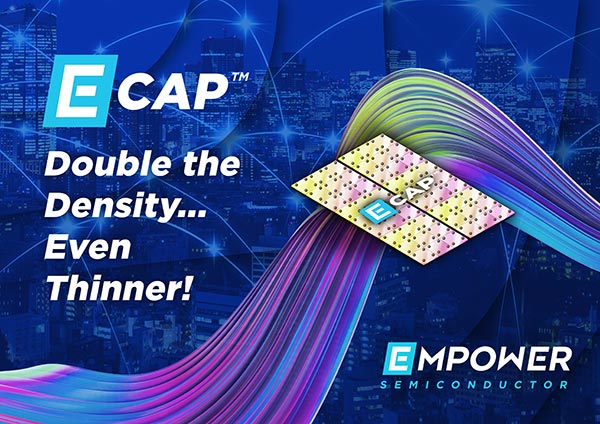 Empower Semiconductor, the world leader in Integrated Voltage Regulators (IVR), has announced that it has expanded its E-CAP™ family of silicon capacitors with new technologies that offer further breakthroughs in density and performance.
Empower Semiconductor, the world leader in Integrated Voltage Regulators (IVR), has announced that it has expanded its E-CAP™ family of silicon capacitors with new technologies that offer further breakthroughs in density and performance.
Integrating multiple discrete capacitances into a single solid-state device, E-CAP is the world’s thinnest, most compact and most flexible capacitor solution. The technology brings together a capacitor density that is over five times that of leading multilayer ceramic capacitors (MLCCs) with improved equivalent series inductance (ESL) and equivalent series resistance (ESR) characteristics that dramatically reduce parasitics.
Designed using the most advanced trench capacitor technology, the latest E-CAP solutions offer densities of 1.1µF/mm2, which is over twice the density of alternative silicon capacitor technologies. In addition to the density, thickness levels can be achieved below 50µm in overall height. Multiple, matched capacitance values from 75pF to 5µF (@2V) can be integrated into a single die to create custom integrated capacitor arrays, while form factors can be customized for the space and height limitations of a particular application. Packaging options based on bumps, pads and pillars allow designers to choose the best solution based on specific system constraints
“E-CAP provides a superior high-frequency de-coupling solution with a much smaller footprint and component count than traditional MLCC-based solutions,” says Steve Shultis, Empower’s SVP of Sales and Marketing. “Our technology provides new options for demanding applications in IoT, wearables, mobile, and processors where size, performance, and flexibility are essential. The latest improvements in density and performance make E-CAP ideal for next-generation, data-intensive systems that demand high-frequency operation and maximum efficiency from the smallest possible form factors.”
Using E-CAP, designers can combine all non-bulk, high-frequency decoupling capacitors into a single die to dramatically reduce component count, BoM cost and potential points of failure. Although the E-CAPs have lower nominal capacitance, their superior frequency response and ESL over MLCCs results in lower impedance at high frequencies. And unlike MLCCs where multiple devices are needed to account for de-rating from voltage, temperature and age, E-CAP requires no AC or DC bias de-rating while all other de-rating requirements are negligible. This eliminates the need to ‘over specify’ capacitance requirements to account for de-rating.


